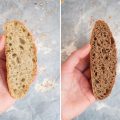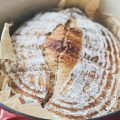Kommissbrot is a classic German bread and a staple in many households. If you’ve ever struggled with dense, flat, or flavorless Kommissbrot, you’re not alone. Here’s a recipe for an authentic, delicious Kommissbrot that will impress your family and friends. I’ll help you achieve a crusty, flavorful loaf, so don’t fret! Let’s learn how to make Kommissbrot.

Table of Contents
- What is Kommissbrot?
- Ingredients
- Preparation
- Mixing
- Shaping and Second Fermentation
- Baking
- Serving and Storage
- Baking Traditional Kommissbrot at Home
- How to Make Kommissbrot: FAQs
What is Kommissbrot?
Kommissbrot, also known as “Soldier’s Bread” or “Commissary Bread,” is a traditional German rye bread. It was created as a long-lasting, nutrient-dense bread for soldiers, but Kommissbrot has become a beloved staple in German cuisine.
This rustic bread is characterized by its dense, chewy texture, deep brown color, and distinctive, slightly sour flavor imparted by the rye flour and sourdough starter used in its preparation. The simplicity of its ingredients – rye flour, water, salt, and sourdough starter – belies the complexity of its taste and the time-honored techniques required to make it.
Kommissbrot’s hardy nature and long shelf life make it a versatile choice for a variety of toppings and accompaniments. It’s a must-try!
Ingredients
- 500 grams rye flour
- 150 grams mature sourdough starter
- 350 milliliters lukewarm water
- 10 grams salt
If you can’t find rye flour, a mixture of 250 grams whole wheat flour and 250 grams all-purpose flour can work in a pinch, but the taste and texture will be slightly different.
Your starter should be bubbly and doubled in size. If you don’t have a starter, you can create one by mixing equal parts of rye flour and water and letting it ferment for a few days.
The water should be neither too hot nor too cold, as extreme temperatures can affect the activity of the sourdough starter.
Sea salt or kosher salt works best, but regular table salt will do in a pinch.
Kitchen Tools
- A large mixing bowl is necessary to combine your ingredients, but any clean bowl or even a stockpot can work.
- An oven is, but if you haven’t got one, a Dutch oven or cast-iron skillet on the stovetop can be used .
- Traditionally, Kommissbrot is baked in a rectangular bread pan, but a regular loaf pan or a shaped round on a baking sheet will do.
- Set of 2 rectangular-shaped loaf pans; ideal for baking bread, pound cake, meatloaf, and more
Prices pulled from the Amazon Product Advertising API on:
Product prices and availability are accurate as of the date/time indicated and are subject to change. Any price and availability information displayed on [relevant Amazon Site(s), as applicable] at the time of purchase will apply to the purchase of this product.
Preparation
Feeding Your Starter
Ensure your sourdough starter is active and ready to go. Feed your starter with equal parts of rye flour and water, and let it sit at room temperature for 8-12 hours, or until it has doubled in size and is full of bubbles. A well-fed starter will have a slightly sour, fermented smell and will be the key to creating a flavorful Kommissbrot.
Timing is Everything
It’s best to feed your starter the night before you plan to bake, so it’s at its peak activity when you’re ready to mix your dough. If you’re not quite ready to bake, you can store your starter in the fridge for up to a week, but be sure to feed it and let it come to room temperature before using it in your recipe.
Maintaining Your Starter
To keep your sourdough starter healthy and active, feed it regularly, even when you’re not baking. If you’re a frequent baker, you can keep your starter at room temperature and feed it daily. If you bake less often, storing your starter in the fridge and feeding it weekly will suffice.
Mixing
In a large bowl, mix the rye flour and salt until they are evenly mixed. Make a small hole in the middle of the flour mixture and pour in the water and sourdough starter. Use a wooden spoon or your hands to slowly mix the flour into the water and starter until a rough dough forms.
Kneading the Dough
Once your dough is mixed, put it on a lightly floured surface and start kneading. Rye dough doesn’t need to be kneaded as much as other bread doughs. Knead for about 5-8 minutes until the dough is smooth and only slightly sticky. If the dough is too sticky, add a little more flour to your work surface. If it’s too dry, wet your hands a bit and keep kneading.
Getting the Right Consistency
The dough should be firm and a little bit sticky, but not so wet that it’s hard to shape. As you knead, pay attention to how the dough feels in your hands. It should be a little hard to knead but still easy to shape. If you’re not sure, pinch off a small piece of dough and roll it between your fingers – it should form a smooth ball without sticking too much to your skin.
Shaping and Second Fermentation
Dividing and Shaping the Dough
After the dough is properly kneaded, lightly flour your work surface and turn the dough out onto it. Divide the dough into two equal parts using a bench scraper or knife. Take each part and shape it into a tight, oval loaf by folding the dough over itself several times and tucking the edges under to create a smooth, rounded top.
The goal is to create a taut surface on the dough, which will help it rise properly and form a crispy crust during baking.
Proofing the Shaped Loaves
Once shaped, place your loaves in proofing baskets or bowls lined with clean, floured kitchen towels. The baskets will help the dough maintain its shape during the second rise. If you don’t have proofing baskets, you can use a bowl lined with a floured towel or simply place the loaves on a baking sheet lined with parchment paper.
Cover the loaves with a damp towel or plastic wrap and let them rise in a warm spot for another 1-2 hours, or until they have nearly doubled in size. This second fermentation is important!
Testing for Readiness
To determine if your loaves are ready for baking, gently poke one with your finger. If the dough slowly springs back, leaving a small indentation, it’s ready to bake. If it springs back quickly, it needs more proofing time. If the dough collapses under your touch, it’s overproofed, but it will still be tasty.
Baking
Preheating the Oven
Before you start baking, preheat your oven to 450°F (230°C). If you have a baking stone, place it in the oven during preheating. A hot stone will help create a crispy crust on your Kommissbrot. If you don’t have a stone, a baking sheet will work just fine.
Preparing the Loaves for Baking
Once your oven is hot and your loaves are fully proofed, it’s time to get them ready for baking. Gently turn the loaves out onto a peel or the back of a baking sheet dusted with cornmeal or flour. This will prevent the bread from sticking.
Baking the Kommissbrot
Carefully slide the loaves onto the preheated baking stone or sheet in the oven. If you want to create steam, which helps develop a crispy crust, you can place a metal pan on the bottom rack of the oven and pour in a cup of hot water right before closing the oven door.
Bake the loaves for about 35-45 minutes. The exact time will depend on your oven and the size of your loaves. The bread is done when it has a deep golden-brown color and sounds hollow when tapped on the bottom.
Cooling and Slicing
Once baked, transfer your Kommissbrot loaves to a wire rack to cool completely before slicing. This cooling time allows the crumb structure to set, making the bread easier to slice.
When your Kommissbrot is cooled, slice it with a sharp, serrated knife and enjoy the fruits of your labor!

Serving and Storage
Serving Suggestions
Kommissbrot is a versatile bread – it pairs well with both sweet and savory toppings. For a traditional German experience, serve it with butter and thinly sliced cured meats like salami or ham. It’s also delicious with strong cheeses like aged cheddar or Gouda. For a sweet twist, try it with honey, jam, or Nutella. Kommissbrot’s robust flavor stands up well to hearty soups and stews too.
Keeping Your Bread Fresh
Store it in a cool, dry place wrapped in a clean kitchen towel or wax paper for up to 3 days. For longer storage, slice the loaf and freeze it in a sealed plastic bag for up to 3 months. When you’re ready to eat, just pop a slice straight from the freezer into the toaster. The dense texture of Kommissbrot means it stays fresh longer than other breads.
Reviving Stale Bread
If your loaf does get a bit stale, don’t toss it! Kommissbrot makes killer croutons, breadcrumbs, and panzanella.
To revive a whole loaf, run it quickly under the faucet to wet the outside, then pop it in a 350°F oven for 5-10 minutes until the crust is crisp again. The steam from the wet crust will refresh the inside too.
Baking Traditional Kommissbrot at Home
Don’t be afraid to create a loaf of this hardy German bread with a crispy crust, tender crumb, and deep, complex flavor. This versatile bread, with its rich history, is worth the effort to make and enjoy, nourishing both the soul and the senses!
How to Make Kommissbrot: FAQs
What are the ingredients in kommissbrot?
Kommissbrot, a traditional German army bread, typically contains the following ingredients: Rye flour (usually around 70%), Wheat flour (usually around 30%), Water, Salt, Sourdough starter or yeast. Some variations may include additional ingredients such as caraway seeds, fennel seeds, or coriander for added flavor. The high rye content gives kommissbrot its dense texture and distinct taste.
How to make fermented dough?
To make fermented dough, follow these steps:
– Mix flour, water, and a starter culture (such as sourdough starter or yeast).
– Allow the mixture to ferment at room temperature for several hours or overnight.
– Add additional flour, water, and salt to the fermented mixture.
– Knead the dough until it becomes smooth and elastic.
– Let the dough rise until doubled in size, then shape and bake as desired.

Kommissbrot (German Rye Bread)
Enjoy baking this hearty and flavorful traditional German Kommissbrot, perfect for a robust meal or a simple, satisfying snack!
- Total Time: 0 hours
- Yield: 2 loaves 1x
Ingredients
- 500 grams rye flour
- 150 grams mature sourdough starter
- 350 milliliters lukewarm water
- 10 grams salt
Tools
- Large Mixing Bowl
- Oven (Alternatively, a Dutch oven or cast-iron skillet)
- Rectangular Bread Pan (or any bread pan you have)
Instructions
- Ensure your sourdough starter is active. Feed it with equal parts rye flour and water, let it sit at room temperature for 8-12 hours until bubbly and doubled.
- In a large bowl, mix the rye flour and salt. Make a well in the center, add water and sourdough starter.
- Mix using a wooden spoon or hands until a rough dough forms.
- Transfer the dough to a lightly floured surface. Knead for 5-8 minutes until smooth but slightly sticky.
- Adjust with extra flour or water as needed for a firm, slightly sticky dough.
- Place the kneaded dough back in the bowl, cover with a damp towel.
- Let it rise in a warm place for 1-2 hours or until nearly doubled in size.
- Flour your surface, divide the dough into two equal parts.
- Shape each into a tight, oval loaf by folding and tucking the edges under.
- Place each loaf in a floured proofing basket or a bowl lined with a floured towel.
- Cover the loaves and let them rise for another 1-2 hours, or until puffy and almost doubled.
- Test readiness by gently poking the dough – it should leave a small indentation.
- Preheat your oven to 450°F (230°C). If using a baking stone, place it in the oven to heat.
- Transfer the loaves onto a cornmeal-dusted peel or the back of a baking sheet.
- Slide onto the hot stone or a baking sheet and bake for 35-45 minutes until deep golden-brown and hollow-sounding when tapped.
- Transfer the baked loaves to a wire rack to cool completely before slicing.
Notes
- If rye flour is unavailable, use a mixture of 250 grams whole wheat flour and 250 grams all-purpose flour for a different texture and taste.
- Serve with butter, cured meats, strong cheeses, or sweet spreads like honey or jam.
- Store in a cool, dry place in a kitchen towel or wax paper for up to 3 days, or freeze for up to 3 months.
- Ensure your starter is bubbly and active for the best flavor.
- Keep your rising dough in a warm, draft-free area for consistent fermentation.
- For a crispier crust, place a metal pan with hot water on the bottom rack of the oven during baking.
- Prep Time: 24 hours (including starter feeding and fermentation)
- Cook Time: 35-45 minutes
- Category: bread
- Cuisine: German







